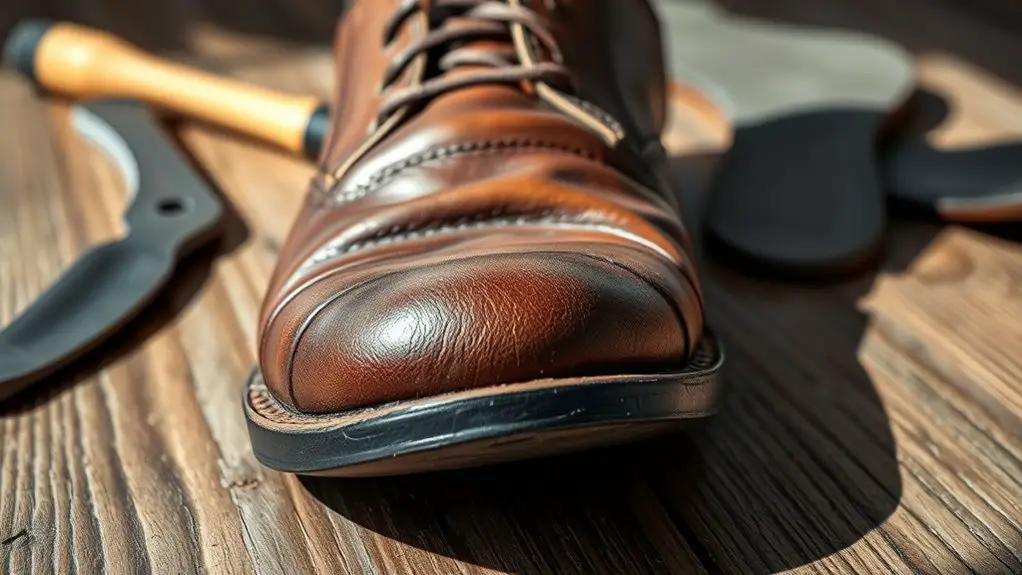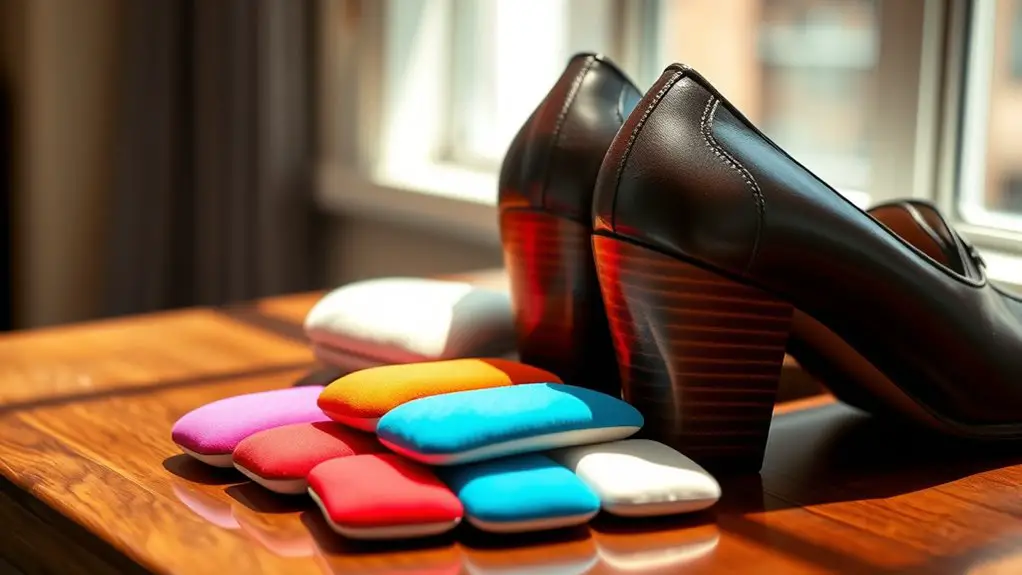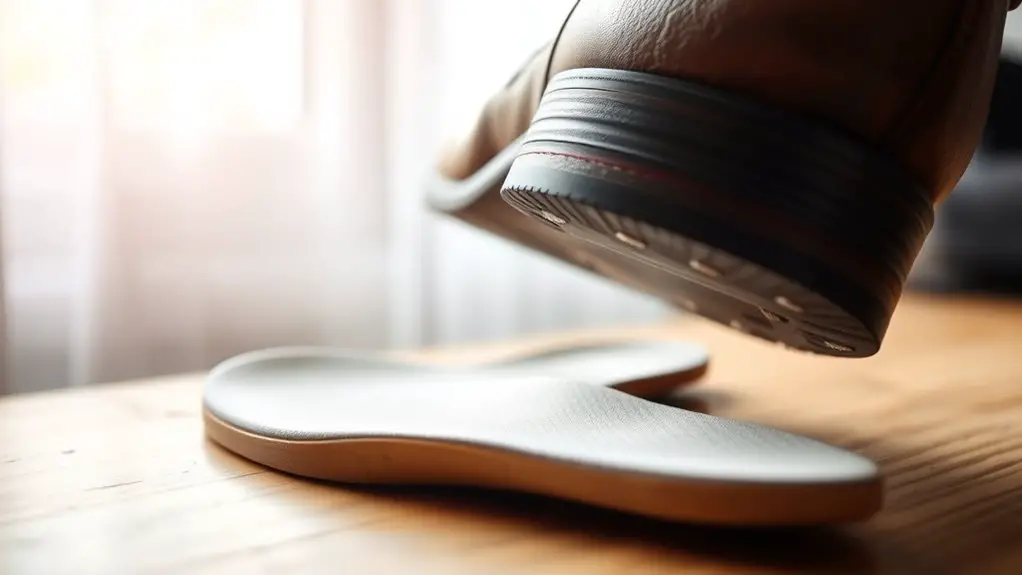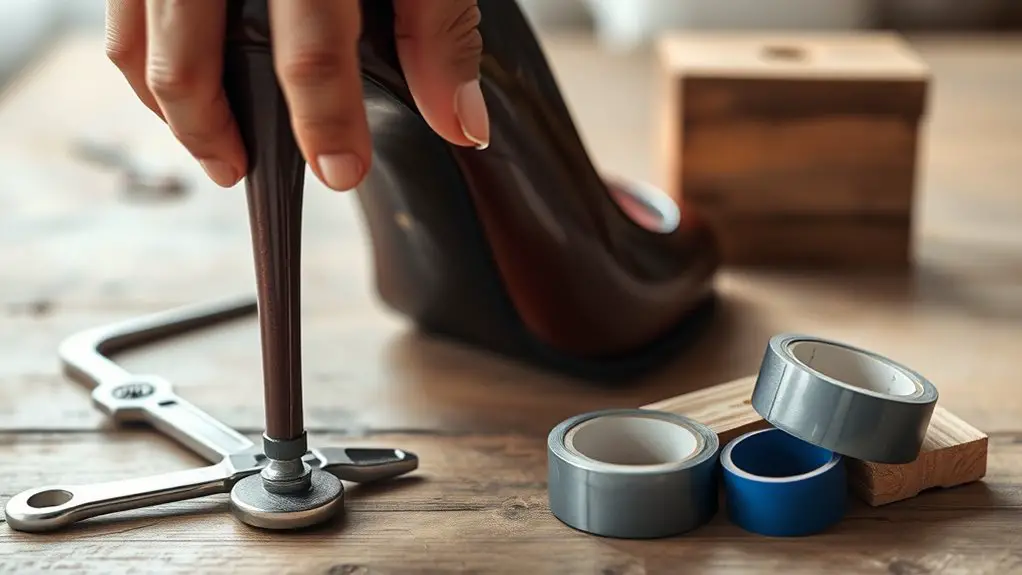If your heel feels too flexible, start by evaluating the cause, such as ligament laxity or tendon issues. Choosing supportive footwear is vital; look for sturdy arch support and firm materials. Consider using heel inserts or cushions for added stability. Strengthening foot and ankle muscles with targeted exercises can improve support. Seeking professional fitting services or custom orthotics might also be beneficial. Maintaining overall foot health is essential, and there’s more to explore on effective solutions.
Assessing the Cause of Flexibility in Your Heel

When you notice excessive flexibility in your heel, it’s essential to evaluate the underlying causes to determine the best course of action. The heel structure plays a significant role in maintaining stability and balance during movement. Any deviation from normal rigidity may indicate an issue with foot mechanics.
Common causes of excessive heel flexibility include ligament laxity, tendon issues, or structural deformities. Ligament laxity can lead to instability, while tendon problems can affect the heel’s ability to absorb shock. It’s also important to take into account the impact of your overall foot mechanics, as improper alignment can exacerbate heel flexibility.
To accurately assess these factors, consulting with a healthcare professional or a podiatrist is advisable. They can perform a thorough examination, including gait analysis, to identify the root cause and recommend appropriate interventions. Understanding the underlying issues is essential for developing an effective treatment strategy.
Choosing the Right Footwear
Selecting appropriate footwear is essential for managing heel flexibility. You should prioritize shoes that offer robust arch support, as this helps stabilize your heel and distributes weight evenly. Look for footwear materials that are firm yet comfortable; options like leather or synthetic composites often provide the necessary structure. Avoid overly flexible designs, as they can exacerbate the issue of heel instability.
When evaluating options, consider the shoe’s heel height and overall design. A slight elevation can enhance support, but excessive height may lead to further complications. Additionally, verify that the shoe fits well; a proper fit reduces unnecessary movement that may contribute to discomfort.
Lastly, consult with a specialist if you’re uncertain about your choices. They can provide tailored recommendations based on your specific foot structure and activity level, guaranteeing you select the most effective footwear for managing your heel’s flexibility.
Using Heel Inserts and Cushions

When addressing a flexible heel, using heel inserts and cushions can provide significant support and comfort. Different types of inserts, such as gel or foam, cater to various needs and can help stabilize your heel during movement. Additionally, cushions enhance shock absorption, reducing strain and discomfort in the heel area.
Types of Heel Inserts
Although heel inserts and cushions vary widely in design and function, they serve an essential role in addressing the discomfort associated with a flexible heel. You’ll find various cushion types, including gel inserts and arch supports, designed to enhance comfort factors. Material options range from foam to silicone, each offering different levels of insert durability and flexibility levels. When selecting an insert, consider insert thickness and heel height; a thicker insert may provide greater support, while the heel height can affect your foot arch alignment. It’s important to match the insert’s characteristics to your specific needs to optimize comfort and reduce the effects of a flexible heel.
Benefits of Cushions
Cushions and heel inserts can greatly enhance comfort for individuals dealing with flexible heel issues. By providing additional support, these products help stabilize the foot, reducing excessive movement that may cause discomfort. There are various cushion types available, such as gel, foam, and air-filled options, each designed to address specific needs. Gel cushions, for instance, offer superior shock absorption, while foam inserts provide a softer feel. The choice of cushion materials also plays a significant role; high-density foam tends to offer durability and consistent support. Incorporating the right cushions not only improves comfort but can also prevent further complications, such as plantar fasciitis or heel spurs. Ultimately, selecting appropriate heel cushions is essential for ideal foot health.
Strengthening Foot and Ankle Muscles
To effectively strengthen your foot and ankle muscles, it’s essential to incorporate targeted strength exercises, balance and stability training, and flexibility and mobility work into your routine. These components not only enhance muscle strength but also improve overall function and reduce the risk of injury. By focusing on these areas, you can achieve a more stable and resilient heel.
Targeted Strength Exercises
When addressing a flexible heel, incorporating targeted strength exercises can greatly enhance the stability and support of your foot and ankle muscles. These exercises promote muscle activation, which is essential for improving overall foot function. Here are three effective targeted exercises to take into account:
- Heel Raises: Stand on the edge of a step and slowly raise your heels, then lower them below the step level. This strengthens the calf muscles and stabilizes the heel.
- Toe Taps: While seated, tap your toes on the ground rapidly, engaging the anterior tibialis. This enhances muscle activation in the front of the ankle.
- Resistance Band Ankle Flexion: Sit and loop a resistance band around your foot. Flex your foot against the band to build strength in the ankle muscles.
Incorporating these exercises into your routine can greatly improve heel stability.
Balance and Stability Training
While many focus on strength training for the foot and ankle, balance and stability training is equally essential for enhancing overall function. Incorporating balance exercises and stability drills into your routine can greatly improve proprioception and muscle coordination.
Here’s a simple table outlining effective exercises:
| Exercise | Description | Frequency |
|---|---|---|
| Single-leg Stand | Stand on one leg, hold for 30s | 3 sets, 3x/week |
| Heel-to-Toe Walk | Walk in a straight line, heel to toe | 3 sets, 10 steps |
| Balance Board | Stand on a balance board, maintain stability | 3 sets, 1 min |
Flexibility and Mobility Work
Incorporating flexibility and mobility work into your routine is essential for strengthening the foot and ankle muscles. By improving flexibility and mobility, you can enhance stability and prevent injuries. Here are three effective strategies:
- Calf Stretch: Stand facing a wall, place one foot back, and press your heel into the ground while leaning forward. Hold for 30 seconds.
- Ankle Circles: While seated or standing, lift one foot off the ground and rotate your ankle in circular motions. Perform 10 circles in each direction.
- Toe Raises: Stand tall and slowly raise your heels off the ground, balancing on your toes. Lower back down and repeat for 15 reps.
Incorporating these flexibility exercises and mobility techniques will greatly contribute to your overall foot and ankle strength.
Seeking Professional Fitting Services
If you’ve tried various home remedies to address your flexible heel without success, seeking professional fitting services may be your next best step. A fitting specialist can provide tailored insights based on their expertise in footwear and biomechanics. They’ll assess your foot structure and gait to identify specific issues contributing to your heel’s flexibility.
By employing various fitting techniques, such as adjusting the shoe’s heel counter or arch support, they can enhance stability and comfort. Professional recommendations may include specific shoe models or brands known for their supportive features.
Additionally, these experts are well-versed in the latest advancements in footwear technology, ensuring that you receive the most effective solutions. Investing time in a professional fitting can lead to improved performance and reduced discomfort, ultimately enhancing your overall foot health. Consider this tailored approach as an essential step in addressing your flexible heel effectively.
Considering Custom Orthotics

Considering custom orthotics can be a pivotal step in managing a flexible heel, as they are designed to provide personalized support tailored to your specific foot structure and gait. Custom orthotic options come in various forms, each offering unique orthotic benefits that can alleviate discomfort and improve stability.
Here are three key benefits of using custom orthotics:
- Enhanced Support: Custom orthotics provide targeted support to areas of your foot that need it most, reducing strain on your heel.
- Improved Alignment: These devices help correct misalignments in your foot and ankle, promoting better overall posture and reducing the risk of injury.
- Increased Comfort: By distributing pressure evenly across your foot, custom orthotics can enhance your comfort during daily activities and physical exercise.
Investing in custom orthotics could considerably improve your heel’s flexibility and overall foot health.
Maintaining Foot Health and Footwear Care
Maintaining foot health is essential to managing flexible heel issues effectively. Regular foot massages can enhance circulation and relieve tension, aiding overall foot wellness. In addition, ensuring proper arch support in your footwear can stabilize your heel and improve alignment.
| Foot Care Tips | Benefits |
|---|---|
| Regular Foot Massage | Increases blood flow |
| Proper Arch Support | Reduces heel strain |
| Quality Footwear Choices | Enhances comfort & support |
Investing in supportive shoes and replacing them when worn out is vital. Always choose footwear that provides adequate arch support, as this can alleviate discomfort associated with a flexible heel. Moreover, keep your feet clean and moisturized to prevent common issues such as calluses or fungal infections. By prioritizing both foot health and appropriate footwear, you’ll create a solid foundation for addressing flexible heel concerns effectively.
Frequently Asked Questions
Can Heel Flexibility Indicate a More Serious Medical Condition?
Yes, heel flexibility can indicate a more serious medical condition, especially if accompanied by heel pain. It’s essential you seek a medical evaluation to rule out underlying issues affecting your mobility and overall foot health.
How Can I Tell if My Shoes Are Too Flexible?
If your shoe’s more flexible than a gymnast, check the shoe material and foot arch support. Too much flexibility can indicate inadequate structure, risking discomfort or injury. Ascertain they provide the support your feet need.
Are There Specific Exercises for Heel Flexibility Issues?
For heel flexibility issues, you should consider a flexibility assessment. Incorporating heel strengthening exercises, like calf raises and toe taps, can improve stability and support, enhancing overall function and reducing discomfort associated with excessive flexibility.
What Are the Signs of Overuse Injuries Related to Heel Flexibility?
Overuse injuries often manifest through symptoms like persistent pain, swelling, and stiffness. A thorough flexibility assessment can help identify issues early, allowing you to address these signs before they escalate into more serious conditions.
Is Heel Flexibility Common Among Athletes or Dancers?
Heel flexibility’s common among athletes and dancers, often resulting from extensive flexibility training. While beneficial for athletic performance, excessive flexibility can lead to instability, increasing the risk of injury if not properly managed.



